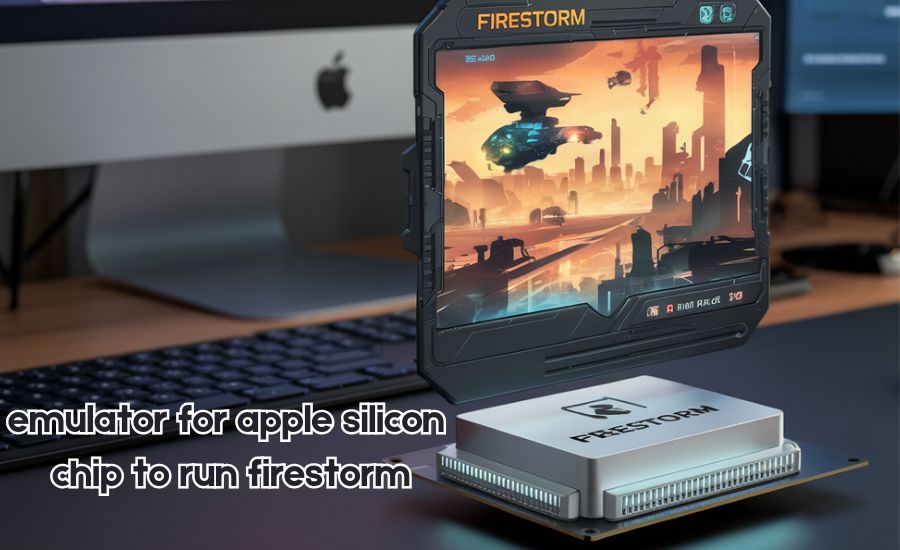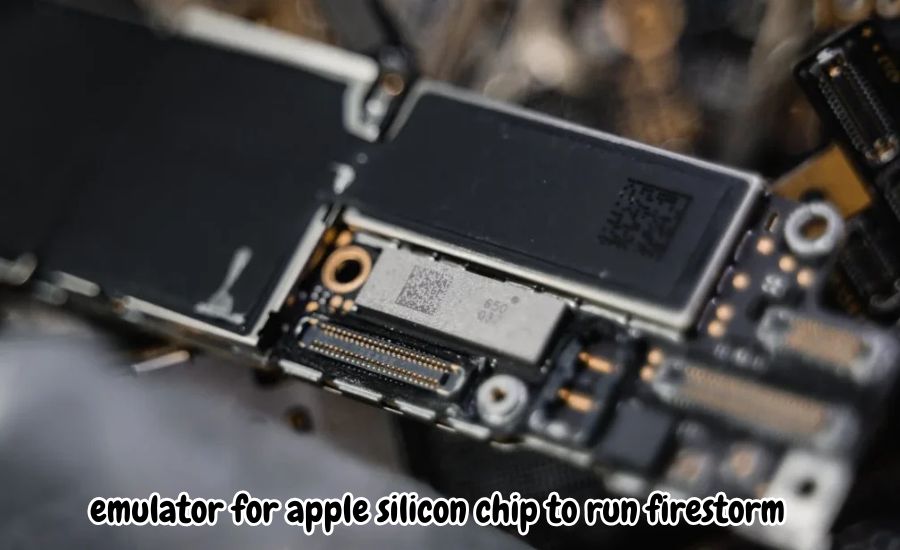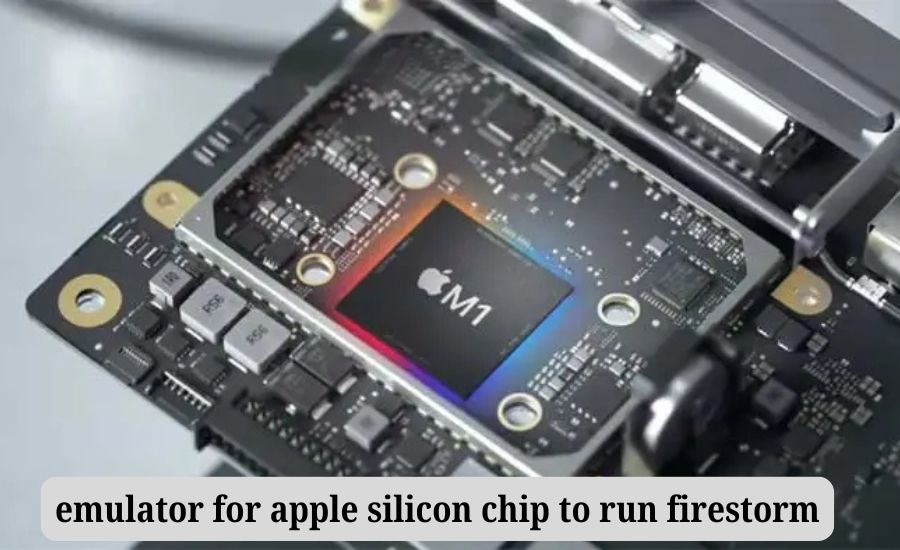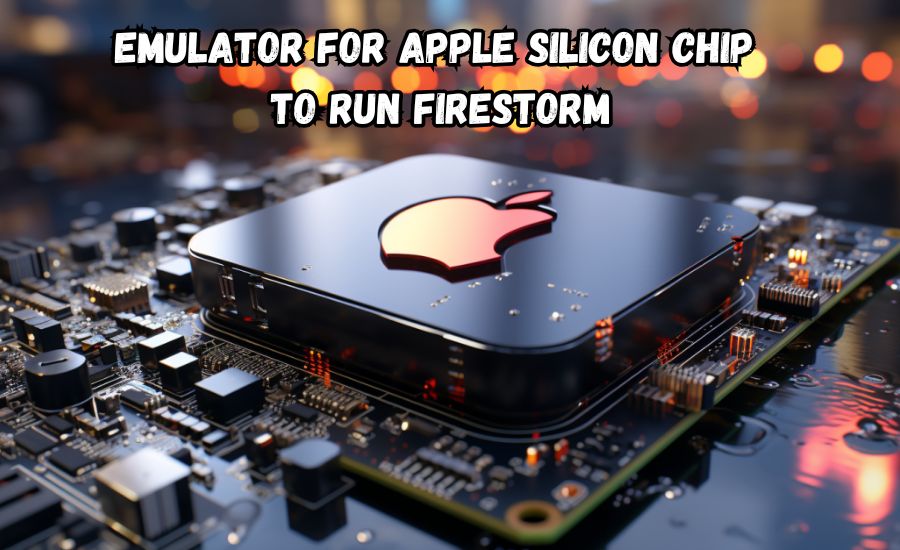Master the Emulator for Apple Silicon Chip to Run Firestorm Effortlessly
If you have an Apple device with an M1 or M2 chip, you might want to use some cool apps like Firestorm. To do this, you need an emulator for Apple Silicon chip to run Firestorm. This special tool helps make apps designed for older computers work on your new device. It’s like a magic bridge that connects the two worlds!
Using an emulator means you can keep enjoying your favorite apps without any problems. In this blog post, we will talk about how to set up an emulator for Apple Silicon chips and get Firestorm running smoothly. Let’s dive in and explore the steps together!
What Is an Emulator for Apple Silicon Chip to Run Firestorm?
An emulator for Apple Silicon chip to run Firestorm is a special program that helps run applications designed for older computers on new Apple devices. When Apple made the switch to its own chips, many apps needed help to work properly. Emulators act like translators, making sure the apps can understand and speak the new language of Apple’s M1 and M2 chips.
Using an emulator is similar to using a bridge. It connects the old and new worlds of technology. This means you can still enjoy apps like Firestorm, even if they were made for different computers. Emulators are very helpful for people who want to use their favorite software on new devices without any hassle.
Every emulator works differently, but they all share the same goal. They take the instructions from an app made for Intel chips and change them so that Apple Silicon can understand. This allows you to keep using your favorite apps like Firestorm, which might not be available in a version made for your new Apple device.
Why You Need an Emulator for Apple Silicon Chip to Run Firestorm
When you get a new Apple device with M1 or M2 chips, you may notice that some apps, like Firestorm, don’t work right away. This is where the emulator for Apple Silicon chip to run Firestorm comes in. It helps these older applications run smoothly on your new machine. Without it, you might miss out on some cool features and fun experiences.
Many people love using Firestorm for exploring virtual worlds. It’s a great way to meet friends and have adventures. However, if you can’t run it on your new device, it can be disappointing. An emulator fixes this problem. It allows you to continue using Firestorm just like you did before.
Emulators are not just for gaming. They can also be used for many different kinds of software. This means you can keep using old favorites while enjoying the speed and efficiency of new devices. So, getting an emulator is an important step for anyone who wants to use Firestorm on their Apple Silicon computer.
How Apple Silicon Chips Changed the Game

Apple made a big change when it introduced the M1 and M2 chips. These new chips are faster and use less energy than the old Intel processors. This means your Apple device can do more tasks while saving battery life. However, this switch also means some apps, like Firestorm, may not work properly without an emulator for Apple Silicon chip to run Firestorm.
The new Apple chips run on a different architecture called ARM. This change can make it tricky for apps built for Intel’s x86 architecture. Many developers are working hard to update their software, but some older apps still need help. Emulators help bridge this gap, allowing users to enjoy their favorite applications like Firestorm until they receive official updates.
These chips also offer better graphics performance, which is great for apps that rely on visuals. Eemulator for apple silicon chip to run firestorm is one of those apps. With the right settings, you can run it smoothly on your new Apple device using an emulator. So, Apple’s changes have opened up exciting possibilities, but emulators are essential for making everything work seamlessly.
Understanding Emulation: A Simple Explanation
Emulation might sound complicated, but it’s really quite simple! It’s like having a magic box that helps your computer act like another type of computer. When you use an emulator for Apple Silicon chip to run Firestorm, you are allowing your new Apple device to understand apps designed for old Intel machines.
Think of it like a translator. When you travel to a different country, you might need someone to translate the language so you can understand what’s being said. Emulator for apple silicon chip to run firestorm do the same thing for your apps. They take the code made for Intel chips and turn it into something Apple Silicon can work with.
Thanks to emulator for apple silicon chip to run firestorm you don’t have to give up using your favorite applications. This is especially important for popular tools like Firestorm. They let you keep enjoying everything you love without missing a beat. So, if you want to run Firestorm on your new device, using an emulator is the perfect solution!
Meet Rosetta 2: Your Assistant for Firestorm
Rosetta 2 is Apple’s built-in solution that helps apps made for older Intel chips run on new Apple Silicon devices. This software acts like an emulator for Apple Silicon chip to run Firestorm, translating the app’s code to work smoothly on your M1 or M2 Mac. Without Rosetta 2, some older apps might not open or function correctly.
When you install Firestorm for the first time on a new Mac, your computer may automatically ask to download Rosetta 2. This is because Rosetta knows how to translate apps like Firestorm, making them run just like they would on older computers. It helps users continue to enjoy virtual worlds on newer devices without any hiccups.
Though Rosetta 2 is not a full emulator, it works similarly. It converts code on the go, making the app compatible. This ensures that you won’t experience major delays or slowdowns while using Firestorm. Having Rosetta 2 available makes the transition to Apple Silicon easier for people who rely on apps like Firestorm every day.
Rosetta 2 isn’t difficult to use since it runs automatically in the background. Once installed, you won’t even notice it’s there, but your apps will work much better. It’s one of the many ways Apple ensures older software remains useful on their latest hardware.
Choosing the Best Emulator for Firestorm
Picking the right emulator for Apple Silicon chip to run Firestorm can make a big difference in your experience. Some emulators work faster, while others are better at handling graphics. To run Firestorm without any issues, you need an emulator that can handle both performance and visuals.
One popular emulator is Crossover, which makes it easy to run many apps, including Firestorm, on Apple Silicon. Another option is Parallels Desktop, which creates a virtual environment where you can install apps just like on older systems. Both options are great for users who want smooth performance.
When choosing an emulator, consider your needs. If you are focused on speed, Parallels might be a good pick. If you want something more lightweight and budget-friendly, Crossover can get the job done. Testing both options may help you find the perfect fit for Firestorm.
Reading reviews and asking other Firestorm users about their experiences with different emulators is helpful too. Everyone’s needs are a little different, so it’s good to see what works best in your case.
Setting Up Your Emulator for Firestorm

Setting up an emulator for Apple Silicon chip to run Firestorm isn’t hard, but it does take a few steps. Start by downloading the emulator you’ve chosen, such as Crossover or Parallels. Follow the instructions on their website to install the program on your computer.
After installing the emulator, open it and create a virtual machine if required. A virtual machine is like a small computer inside your computer. It allows you to run apps like Firestorm that need a different system to work. The emulator makes this process simple by guiding you step by step.
Once your virtual machine or environment is ready, you can start installing Firestorm. Make sure to adjust the emulator settings for performance and graphics to get the best experience. Proper settings help avoid crashes and ensure smooth gameplay.
Setting things up might take 15-30 minutes, but once done, you’ll be ready to explore virtual worlds without interruption. If you run into trouble during setup, check online guides or forums for solutions.
Installing Firestorm on Your Emulator
After your emulator for Apple Silicon chip to run Firestorm is installed, the next step is to download Firestorm. Go to the Firestorm website and choose the version that works best with your emulator. Once the download finishes, open the emulator and follow the instructions to install it.
During installation, you may need to adjust some settings, like storage or display options. These settings ensure Firestorm runs smoothly and without lag. If your emulator offers an automatic setup feature, use it to make things easier. It helps avoid any guesswork.
After installation, log into your Firestorm account and test the app. Make sure everything is working well. If you experience slow performance, try tweaking the emulator’s settings. Sometimes adjusting the graphics quality can improve speed without affecting your experience.
When everything is set, you can dive into Firestorm and enjoy your virtual adventures. With the right emulator, Firestorm will feel just as fun as on older devices.
Tips for Optimal Performance with Firestorm
To get the best results when using an emulator for Apple Silicon chip to run Firestorm, try to keep your software updated. Emulators and Firestorm developers often release new updates that fix bugs and improve performance. Keeping everything updated helps avoid crashes.
Closing unnecessary apps while running Firestorm can also improve performance. Since emulators use extra resources, having fewer apps open allows the emulator to focus on running Firestorm smoothly. It’s a good habit to restart your computer before a long session to free up memory.
Adjusting in-game settings can also make a difference. Lowering the graphics or resolution can make Firestorm run faster, especially on older or less powerful devices. The key is to find a balance between visuals and speed that works for you.
Lastly, remember to back up your Firestorm data regularly. This ensures you don’t lose progress or settings if something goes wrong.
Common Issues When Using an Emulator for Firestorm
Using an emulator for Apple Silicon chip to run Firestorm can sometimes come with challenges. One common issue is that the app may run slower than usual. Since the emulator works as a translator, it takes time to process information. As a result, users might notice some delays or lag when using Firestorm on their new Apple device.
Another issue is that some features in Firestorm may not work correctly. Emulators are helpful, but they cannot always translate every part of the app perfectly. Sometimes, the graphics might appear blurry, or certain tools in the app may crash. This can make it frustrating for users trying to enjoy their virtual adventures.
Connectivity problems can also occur. Firestorm needs a stable internet connection, and emulators can sometimes interfere with that. If the connection drops or feels slow, the user experience may suffer. These small issues can be annoying, but with patience, most can be resolved by adjusting the emulator settings or restarting the app.
Troubleshooting Your Emulator for Firestorm
If you encounter problems with the emulator for Apple Silicon chip to run Firestorm, there are several ways to fix them. First, make sure you have the latest version of the emulator. Updates often contain bug fixes that help improve performance and compatibility with apps like Firestorm.
Another helpful step is adjusting the settings. Some emulators let you change how much computer power they use. Increasing the resources given to the emulator can reduce lag and make Firestorm run more smoothly. You can also try lowering the graphics quality in Firestorm to improve performance.
Restarting your device or reinstalling the emulator can also fix many problems. Sometimes, a fresh start is all you need. If you still experience issues, checking online forums where other users discuss Firestorm might help. Many users share useful tips and tricks that solve common emulator problems.
The Benefits of Using an Emulator for Firestorm

There are many reasons to use an emulator for Apple Silicon chip to run Firestorm. One big benefit is that it allows you to run older software that might not be available for Apple’s new chips. Without an emulator, you could miss out on using Firestorm on your new device.
Emulators also give users more flexibility. You can keep using apps you love without waiting for developers to release new versions. Firestorm is popular among many users, and an emulator makes it easy to continue enjoying it, even on the latest Apple devices.
Another advantage is that emulators let you access all the features of Firestorm. Some apps lose functionality when updated, but by using an emulator, you can use the original version of the app just as it was meant to be. This makes the emulator a valuable tool for people who want the best virtual experience.
Challenges of Running Firestorm on an Emulator
Even though an emulator for Apple Silicon chip to run Firestorm is helpful, it also brings some challenges. One major issue is that emulators can slow down your computer. Running both the emulator and Firestorm together requires a lot of memory and processing power, which can make your device run slower.
Another challenge is the possibility of bugs and crashes. Emulators are not perfect and may struggle to translate every part of Firestorm smoothly. Users sometimes experience glitches, such as missing graphics or freezing screens, which can affect their experience.
Compatibility issues are another concern. Not all emulators work well with every app, and Firestorm may require specific settings to function properly. Finding the right emulator and adjusting the settings can take time, but once everything is set up correctly, the experience becomes much better.
Looking Ahead: The Future of Emulation for Firestorm
The future of emulation is exciting for users who rely on an emulator for Apple Silicon chip to run Firestorm. As Apple continues to improve its Silicon chips, emulators are also evolving. Developers are working hard to create faster and more efficient emulators that can run complex apps like Firestorm without any problems.
In the coming years, we may see emulators that offer even better performance. Future versions could reduce lag, fix bugs, and make apps like Firestorm run almost as smoothly as they would on older devices. This means users will no longer need to worry about missing out on their favorite apps.
There is also a chance that Firestorm developers will release a version specifically made for Apple Silicon chips. If that happens, emulators may no longer be needed. Until then, emulators will remain an important tool, ensuring that users can continue to enjoy their favorite virtual worlds on Apple’s latest devices.
Conclusion
Using an emulator for Apple Silicon chip to run Firestorm can be both helpful and tricky. It allows users to run Firestorm on new Apple devices, even if the app wasn’t made for the latest chips. However, it also comes with challenges like lag, bugs, and crashes. With patience and the right settings, most of these problems can be fixed, letting users enjoy their virtual adventures smoothly.
In the future, emulators will likely improve, making Firestorm run even better on Apple’s new chips. Developers may also release a Firestorm version just for Apple Silicon, which would make things easier. Until then, using an emulator is a great way to keep enjoying Firestorm on your new device. It may take some time to set up, but the fun and adventure make it worth the effort!
Learn More: Jlittleone-onlyfans-everything
FAQs
Q: What is an emulator for Apple Silicon chip to run Firestorm?
A: An emulator helps Firestorm, built for Intel-based systems, run smoothly on Apple’s ARM-based M1 and M2 chips by translating code.
Q: Which emulator works best for running Firestorm on Apple Silicon?
A: UTM and Parallels Desktop are popular choices. UTM is free and open-source, while Parallels offers better performance with easy setup.
Q: Can I run Firestorm directly on an Apple Silicon chip?
A: Firestorm is not optimized for Apple Silicon yet, so using an emulator ensures it runs without major issues.
Q: What challenges might I face when using an emulator for Firestorm?
A: You might experience slower graphics, missing features, or occasional crashes due to the emulation layer.
Q: How can I improve Firestorm’s performance on an emulator?
A: Allocating more CPU and memory to the virtual machine, keeping software updated, and tweaking graphics settings can help.
Q: Does Rosetta 2 help Firestorm run on Apple Silicon?
A: Rosetta 2 translates Intel apps for Apple Silicon, but Firestorm may need an emulator for better performance and stability.
Q: Is using an emulator legal and safe?
A: Yes, using an emulator like UTM or Parallels is legal, as long as you have proper licenses for the operating systems you install.
Q: Will Firestorm ever get native support for Apple Silicon?
A: It’s possible. Developers may release an optimized version for Apple Silicon in the future, making emulators unnecessary.





Post Comment